In a bid to become less reliant on conventional sources of energy production like thermal (using coal and Petroleum) and Hydro, Gujrat government was leaning towards the use of Solar Plants for generation of clean energy for the state. While the world was struggling with poor percentage of power generation leading to higher per unit costs, Gujrat government was looking at innovative ideas for lowering the per unit cost of power generation using solar panels.
The government wanted to move fast so that some substantial electrical generation could be achieved using solar plants, before the end of the term of the elected government.
The biggest hurdle in the way was not finance but the acquisition of huge amounts of lands for the placement of solar panel arrays for generation of electricity. The land acquisition laws of the country had always been a source of major headaches and major project delays.
A lot of ideas were raised and considered for the location of solar power plants. The government think tank were also struggling with various ideas that could reduce the cost of power produced by the solar pants.
Someone in the Gujrat government (not sure who, as this information could not be obtained from the ministry) close to the Chief Minister suggested that solar panels could be placed on top of the several water canal systems that existed in Gujrat state. This would completely eliminate the need for any land acquisition whatsoever.

This idea created a lot of flutter but at the same time a lot of people from the Narmada Canal Systems put forth the following objections against the proposal. Some of these objections were: -
1. Covering of the canal with solar panels would make the extraction or pumping out of water from the canals for irrigation difficult if not impossible.
2. Anyone or cattle slipping into canal upstream may get washed into the canal where they are covered with solar panels thus making the extraction or rescue almost impossible.
3. Cleaning of the canal under the solar panels would be a mammoth task and a very difficult task adding to the cost of maintenance of the canal.
4. Corrupt citizens who are used to making breaches in Canal Systems to illegally irrigate their fields my inadvertently damage the solar panels resting on the canal walls that would be breached.
5. Chemicals in the photovoltaic cells may drip (due to damage) and contaminate the water supply with dangerous chemicals.
6. Theft of the solar panels for alternate uses may happen as well.
Most of these objections being of a rather serious nature a feasibility study was initiated. This study was done by an independent body and it was found that if certain precautions were taken almost all the objections raised could be easily addressed while using the canal for placing the solar panels for generation of power.
The government decided to take it easy and not jump to conclusions and hence instead of going ahead with a full-fledged power plant, it sanctioned a “Pilot Project” that would help prove the theory in practice before using it as a template for larger and more ambitious projects. Besides, if this trial did not succeed it would not be a huge loss either and the idea would be shelved thereafter.
A proposal for the pilot was circulated and finally the US Based company SunEdison was selected as they had had past experiences of building solar plants over Lakes and river bodies.
The planning for this was in done in conjunction with the key stakeholders from PMO of the State Government, Sardar Sarovar Narmada Nigam Ltd (SSNNL), Gujrat State Electricity Corporation (GSEC) and representatives from the local village panchayats (a democratic local village regulatory and governance body overseeing the village local affairs). This ensured that the plans encompassed the suggestions, inputs as well as risks of all the three major players to this pilot project.
The entire design was done in several iteration to ensure that the design would become componentized template that could be scaled up for larger and larger such projects in future. A lot of time was also spent on finding cheaper and more durable design that would ensure that panels do not budge or topple over even while facing gale force winds of 150km per hour. The design was also to include the solutions to the objections raised by SSNNL regarding cleaning and emergency situations in the canal. The panchayat bodies put forth their accessibility needs connected to the water canal, while accepting their contribution of time for manual security and overseeing safety measures during accessing water from the canal.
Once the design was finalized the construction started in a typical waterfall style with minimum redundancy of equipment and material to avoid any kind of wastages.

The overall design was to place the solar panels across the two walls of the canal such that the rows of panels would become a lid like cover on the canal. This ensured that no land would have to be acquired.
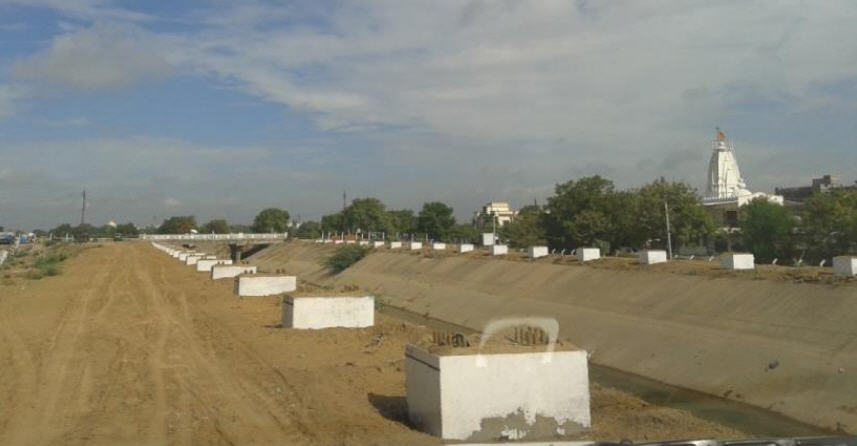
The panels were raised from one side to face the sun at a sloping angle. The design also put gaps in arrays of solar panels to ensure that the curves in the canal would not end up making the panels face away from the sun.
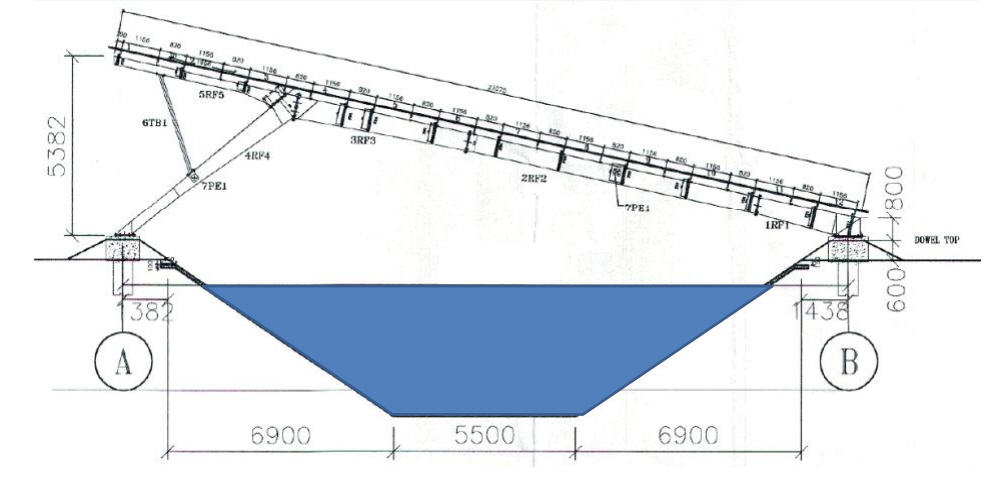
Gaps were provided in arrays to coincide with the pedestrian steps made on the inside walls of the canal to allow the local villagers to step into the canal to fetch water for their daily needs.
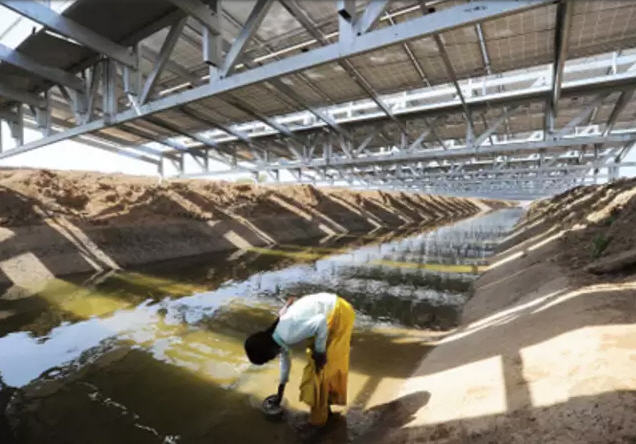
For the prototype a stretch of 750 meters of canal was selected near Chandrasan Village in the Mehsana district of Gujrat. The total cost was estimated to be 17.50 Crore Indian Rupees. And its output was targeted to be 1 megawatt.
The entire project was completed before time in just under 10 months and finally inaugurated by the Chief Minister on April 24th, 2012.
After 3 yrs of its operations the following information came to light: -
-
The project finished exactly on budget and before time.
-
The design turned out to be scalable and repeatable without much adaptation (this was proven in 2015 when 10 MW project was completed in record time and under budget at Vadodara, Gujrat and inaugurated by the Ban Ki Moon, then UN General Secretary. )
-
The design allowed for easy access to water for the tribal and the villagers.
-
The use of light weight panels with quartz technology has ensured that there have been no leakages of any kind of chemicals into the water.
-
Gaps have been provided among the arrays of panels to allow for undertaking of cleaning or any kind of emergency extraction services.
-
The cleaning of the solar panels becomes easy as the water from the canal was used directly to wash the dust off the panels and they would just drip back into the canal through specifically designed gutter systems running parallel to the panels.
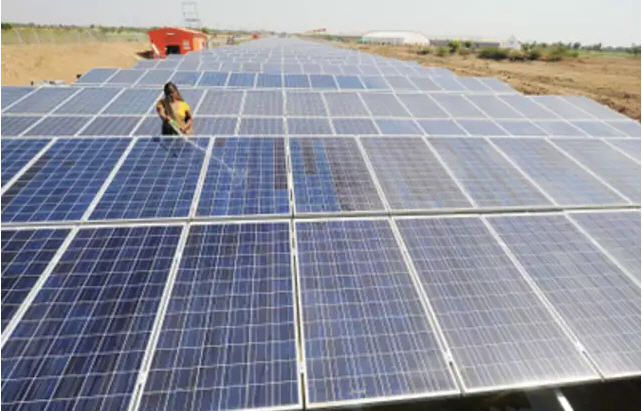
-
It is now estimated that in just that 750 meters of stretch of canal the solar panel covering prevented water evaporations to the extent of 34 million litres of water every single year.
-
Because of the fact that the covering allows hardly any sun rays to reach the canal bottom, less grass and algae growth happened in the canal thus drastically reducing the need for maintenance activities.
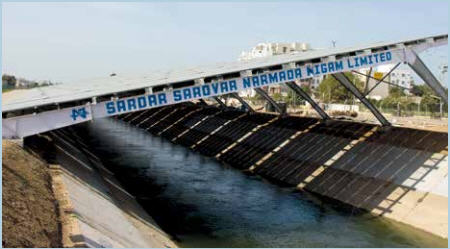
-
Animal friendly mesh at the start of the solar panel coverage on the canal also prevented any kind of animals being washed under the solar panels.
-
Because of the fact that the solar panels on the canal created tunnel effect for the winds blowing, the natural high velocity of cool air kept the temperature of the solar panels so low, even during scorching summers, that the panels kept producing electricity at near total levels throughout the year.
-
The CCTV coverage of the operations of this Canal Top Solar Power Generation has ensured that not a single breach of the canal walls or any kind of stealing of water has happened in the last 4 yrs.
-
After 4 yrs of implementation the experts have found out that the life of these panels over canals is much more than those put over the land mass. Currently these solar panels have been certified to have life of much beyond 25 yrs.
-
The canal top solar plant produced the lowest ever cost of solar plant power production in the world, at just INR8.00 per unit.
-
It has been producing 1.6 million units per year since its operations.
-
Since hardly any infrastructure was created, this form of solar power plant is the most environmentally friendly installation among all kinds of solar plants.
This pilot has been so successful followed by the resounding success of the 10MW plant on the canals near Vadodara, the State Government has now initiated projects of Canal Top Solar Plants around the state to cover not less than 10% of the total canals that they have in the state. Gujrat has 19,000 km of canals. All this would be done before 2022 and by the time all these Canal Top Solar Plants are completed they would end up producing a minimum of 2,200 MW of clean power every single year.
Oh by the way, this pilot was the first project of this kind ever in the world where canals were used for laying solar panels for power production. Now several countries are trying to do the same.
Some of the factors that lead to the immense success of this project were:
1. Making sure that all the (as well as only) necessary stakeholders were involved in the planning as well as designing of the project specifications.
2. Being open to criticism and unproven ideas allowed the project to be flushed with interesting ideas that only needed practical validation.
3. Essential and practical risk management with preventive and yet less costly solutions ensured that the project does not become unnecessarily risky or costly.
4. Instead of going all out with a huge big-budget project, a trial was done to not only test the validity of the idea but also to make the design so componentized that its replication would need minimum planning as well as redesign while making it highly scalable.
5. The bureaucrats were tasked with enablement and facilitation and also made accountable for the outcome of the project leading to one of the best “Private – Public” synergy ever seen anywhere in the world.
6. Effective and detailed cost estimation allowed for ensuring tracking of the project both time wise as well as cost wise. This also helped in finishing the project under-budget.
No wonder this project finds mention in the PM-Pulse list of “Best Projects” in the world.